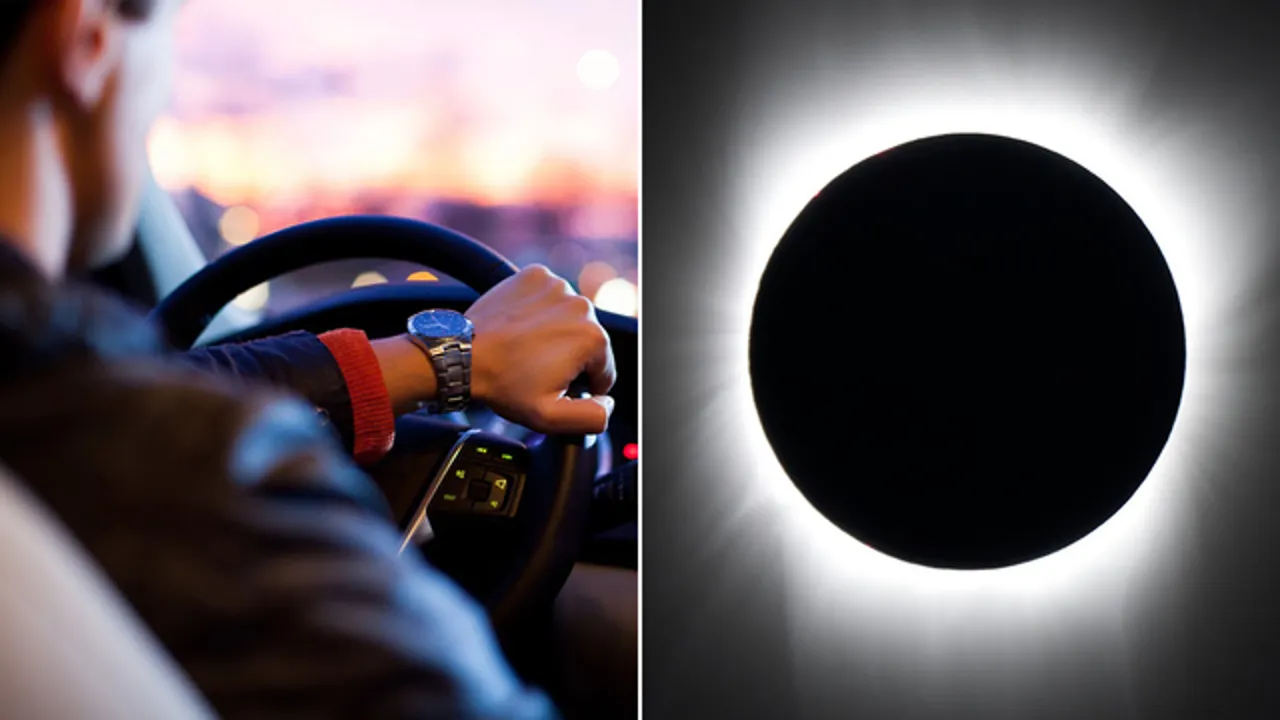Driving safety is always a priority, but unique events like a solar eclipse present additional challenges. Whether you’re an eclipse enthusiast or find yourself unexpectedly driving during one, understanding the potential risks and how to mitigate them is crucial.
Understanding a Solar Eclipse
A solar eclipse occurs when the moon passes between the Earth and the sun, casting a shadow on Earth. This celestial event can be partial, annular, or total, depending on the alignment of the sun, moon, and Earth.
Types of Solar Eclipses
- Partial Solar Eclipse: Only a part of the sun is obscured by the moon, resulting in a partial dimming of the sun’s light. This type of eclipse can create a crescent sun appearance.
- Annular Solar Eclipse: The moon covers the center of the sun, leaving a ring-like appearance known as the “ring of fire.” This occurs because the moon is too far from Earth to completely cover the sun.
- Total Solar Eclipse: The moon completely covers the sun, plunging an area into temporary darkness. This is the most dramatic type of eclipse and can turn day into night for a brief period.
Visibility Challenges During a Solar Eclipse
The sudden shift from daylight to twilight or darkness can be disorienting. Drivers may experience reduced visibility, similar to driving at dawn or dusk. Adjusting to these changes quickly is essential to maintain safety on the road.
- Rapid Light Changes: The transition from bright daylight to the dim light of an eclipse can be jarring. Eyes may take time to adjust, leading to a temporary reduction in visibility.
- Glare and Shadows: Partial eclipses can create unusual shadows and glare, which may affect depth perception and make it difficult to see road hazards.
Potential Distractions on the Road
A solar eclipse is a rare and captivating event, likely to distract not just drivers but also passengers, pedestrians, and cyclists. It’s important to remain vigilant and anticipate that others around you might not be paying full attention.
Drivers and Passengers Distracted by the Eclipse
It’s natural to want to glance at the sky during an eclipse. However, taking your eyes off the road, even for a moment, can lead to accidents. Ensure your passengers are aware of the dangers of distracting the driver.
- Driver Temptation: The urge to look at the eclipse while driving can be strong, but even a brief distraction can result in a collision.
- Passenger Behavior: Passengers might become excited and inadvertently distract the driver by pointing out the eclipse or moving around in the vehicle.
Pedestrians and Cyclists Looking at the Sky
People on foot or on bikes might stop suddenly or wander into the road while looking up at the eclipse. As a driver, be prepared for unpredictable behavior from those around you.
- Pedestrian Hazards: Pedestrians might step into the street without looking, posing a risk to themselves and drivers.
- Cyclist Inattention: Cyclists may veer off course or stop abruptly, creating potential obstacles for drivers.
Safety Precautions While Driving During a Solar Eclipse
Turning on Headlights
During a solar eclipse, the light levels drop, and having your headlights on can improve visibility for you and make your vehicle more visible to others.
- Enhanced Visibility: Headlights help ensure that other drivers, pedestrians, and cyclists can see your vehicle, reducing the risk of accidents.
- Automatic Headlights: If your vehicle has automatic headlights, ensure they are functioning correctly before the eclipse.
Keeping Your Eyes on the Road
It’s tempting to watch the Driving During a Solar Eclipse, but safety should come first. If you want to view the eclipse, find a safe place to pull over.
- Dedicated Viewing: Plan to stop at a safe location, such as a designated viewing area or a parking lot, to watch the eclipse without compromising safety.
- Avoiding Distractions: Remind yourself and your passengers that focusing on the road is the top priority during the eclipse.
Best Practices for Drivers
Pulling Over Safely to Watch the Eclipse
If you plan to watch the eclipse, do so from a safe location off the road. Avoid stopping on the shoulder or in any place that could obstruct traffic or create hazards.
- Safe Locations: Look for rest areas, parking lots, or designated viewing spots well in advance.
- Avoid Roadside Stops: Stopping on the shoulder or in active traffic lanes is dangerous and can cause accidents.
Using GPS and Navigation Tools
Plan your route ahead of time and use GPS to avoid getting lost. Real-time traffic updates can help you navigate potential congestion or roadblocks.
- Pre-Planning: Identify safe stopping points and alternate routes before the eclipse begins.
- Real-Time Updates: Use apps that provide live traffic updates to stay informed about road conditions and potential delays.
Equipment to Carry
Safety Gear and Emergency Kits
Having a well-stocked emergency kit in your car is always a good idea. This should include first aid supplies, flares, and basic tools.
- First Aid Supplies: Include bandages, antiseptics, pain relievers, and any necessary medications.
- Emergency Tools: Carry flares, a flashlight, batteries, a multi-tool, and a blanket for unexpected situations.
Solar Viewing Glasses
If you plan to view the eclipse, ensure you have ISO-certified solar viewing glasses. Regular sunglasses won’t protect your eyes from the harmful rays of the sun.
- Certified Glasses: Only use glasses that meet the ISO 12312-2 international safety standard for direct solar viewing.
- Availability: Purchase solar viewing glasses well in advance, as they can sell out quickly before an eclipse.
Handling Increased Traffic
Planning Your Route
Check local news and traffic reports to avoid heavily congested areas. Use alternate routes if necessary.
- Local Updates: Monitor local news sources for information on road closures, detours, and traffic conditions.
- Alternate Routes: Plan multiple routes to your destination in case your primary route is congested or closed.
Being Patient and Alert
Increased traffic can lead to frustration, but staying calm and focused is essential. Anticipate sudden stops and keep a safe distance from the car in front of you.
- Calm Driving: Practice patience and avoid aggressive driving behaviors such as tailgating or lane weaving.
- Safe Following Distance: Maintain a greater following distance than usual to allow for sudden stops and erratic behavior from other drivers.
Avoiding Accidents
Staying Focused on Driving
Distractions are a leading cause of accidents. Commit to focusing solely on driving when you’re behind the wheel.
- Minimize Distractions: Turn off or silence electronic devices and keep conversations to a minimum.
- Stay Alert: Continuously scan the road and mirrors for potential hazards.
Understanding Common Causes of Accidents During an Eclipse
Common causes include distracted driving, sudden stops, and reduced visibility. Awareness of these factors can help you avoid them.
- Distraction: Keep in mind that your attention should remain on the road, not on the sky.
- Visibility: Adjust your driving speed to match the reduced visibility conditions during the eclipse.
Dealing with Emergency Situations
What to Do If You Encounter an Accident
If you come across an accident, ensure your safety first. Use your hazard lights to alert other drivers and call emergency services.
- Stay Safe: Do not attempt to move injured individuals unless they are in immediate danger.
- Signal and Report: Use hazard lights and flares to alert other drivers and call 911 to report the accident.
Contacting Emergency Services
Have emergency numbers programmed into your phone. Provide clear information about your location and the nature of the incident.
- Precise Information: Give the dispatcher clear and concise details about your location and any injuries.
- Preparedness: Keep a list of emergency contacts and important information in your vehicle’s glove compartment.
Legal Considerations
Traffic Laws Specific to Eclipse Events
Some areas may implement special traffic regulations during an eclipse. Stay informed about any temporary laws or road closures.
- Temporary Regulations: Be aware of any local ordinances or special rules that might be in effect during the eclipse.
- Compliance: Follow all traffic signs, signals, and instructions from authorities.
Penalties for Distracted Driving
Distracted driving can carry severe penalties, including fines and points on your license. Avoiding distractions is not just about safety but also about staying on the right side of the law.
- Legal Consequences: Understand that distracted driving laws vary by state, but penalties can be significant.
- Zero Tolerance: Make a personal commitment to avoid all forms of distraction while driving.
The Role of Authorities
Advice from Traffic Authorities
Authorities typically issue guidance on safe driving practices during an Driving During a Solar Eclipse. Following their advice can enhance your safety.
- Official Recommendations: Pay attention to advice from traffic authorities, including recommended driving behaviors and safety tips.
- Public Announcements: Look out for public service announcements and alerts related to the eclipse.
Roadblocks and Checkpoints
Be aware that authorities may set up roadblocks or checkpoints to manage traffic and ensure safety. Cooperate with these measures for a smoother experience.
- Traffic Control: Understand that these measures are in place to ensure public safety and manage increased traffic.
- Cooperation: Follow all instructions from law enforcement and traffic control personnel.
Public Awareness Campaigns
How Authorities Spread Awareness
Public service announcements, social media campaigns, and community meetings are common methods to spread awareness about safe driving during an eclipse.
- Information Channels: Stay informed through various channels such as local news, social media, and community bulletins.
- Engagement: Participate in community events and meetings to stay updated on safety measures and eclipse-related information.
Tips for Public Safety
Simple tips like turning on headlights, pulling over safely, and avoiding distractions are often emphasized in these campaigns.
- Basic Tips: Follow basic safety advice such as using headlights, pulling over in safe areas, and avoiding distractions.
- Widespread Education: These tips are often repeated in multiple formats to ensure wide reach and understanding.
Conclusion
Driving during a solar eclipse presents unique challenges, but with the right precautions, you can stay safe. Remember to keep your eyes on the road, use your headlights, and pull over safely if you want to view the eclipse. Stay informed about local traffic conditions and laws to ensure a smooth experience. By planning ahead, staying alert, and following safety guidelines, you can enjoy the eclipse without compromising your safety or that of others on the road.







